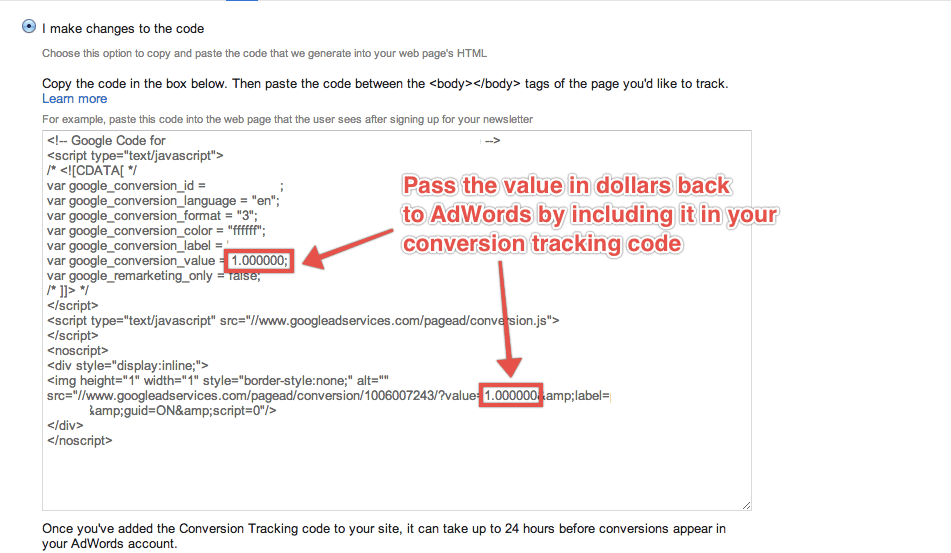
Ever wondered why Google AdWords makes you pay more to appear higher on the page?
Like many business owners I speak to, you may think they charge more because people are more likely to buy from you if you’re in a top position.
Well, this isn’t quite accurate – and the subtle misunderstanding can seriously hamper your ability to run a profitable AdWords campaign.
Here is the one piece of information that can help you generate a positive ROI from your AdWords spend immediately:
Conversion rates don’t vary with ad position.
In other words, an ad in top position will generate more clicks but won’t generate more conversions per click.
Why does this matter so much? Let’s look at an example.
Say you have a website that sells ladies shoes and you find that the exact match keyword “ladies shoes” converts at 2%, with an average purchase amount of $60 (out of which $30 is profit).
If your average CPC for this keyword is $2, then you’ll get $30 profit for every $100 you spend. In other words, you’ll lose $70 on average for each sale you make.
Booooo!
Now, let’s say your objective is to break even on AdWords spend to acquire a new customer, knowing that you should be able to follow up via email to generate repeat purchases.
This means that for the 50 clicks it takes to get you one conversion, you can only afford to pay $30. Accordingly, your max CPC should only be:
30/50 = $0.60/click
If you adjust your max CPC for that keyword to $0.60, you’ll hit your target of breaking even for each new customer you acquire through AdWords.
I realize this sounds too good to be true. Not making a profit from AdWords? Just give them less money!
So what’s the catch?
When you reduce your bid, your ad position decreases.
If your initial $2/click bid was getting you an average position of 1.4 (i.e. it was at the top most of the time) and you were getting 50 clicks each week, you might find that your new bid of $0.60/click gets you an average position of 5.8 and it takes you 8 weeks to get the same 50 clicks.
The difference is that by the time you get the 50 clicks you will have broken even on your ad spend instead of losing $70.
In some cases, however, you may find that reducing your bid will lower your position so much that you don’t get any clicks at all. The only way to generate a return for those keywords is by improving your conversion rate or increasing your lifetime customer value…
The importance of lifetime customer value
When you record a conversion using AdWords conversion tracking, you can assign a “conversion value”:
This tells AdWords how much money the conversion was worth to your business.
This can be the same for each conversion. For example, you might use your “average revenue per user” for a SaaS business. Alternatively, you can change the value for each conversion; on an eCommerce website, you might set the conversion value to be the total transaction value for a sale.
Once you are attributing a value to each conversion, you will be able to use the Value/Cost field in AdWords to determine which keywords aren’t performing at your target ROI.
This seems pretty simple, but deciding what value to assign to each conversion is a subtle and critical decision. Let’s look at some scenarios in which assigning the wrong value to your conversions could seriously throw your numbers off:
Example 1: For the website that sells ladies shoes, if you only base your bid adjustments on a single average purchase value, you won’t be taking into account the fact that people who search “ladies evening shoes” typically spend more than people who search for “ladies flip flops”.
Example 2: If you’re running a SaaS business which makes accounting software, you might find that people who sign up for a free plan after searching for “tax compliance software” generally end up upgrading to your most expensive plan, whereas people who sign up for a free plan after searching “free accounting software” never upgrade to a paid plan at all.
In both eCommerce and SaaS businesses, there is a tendency to use a variant of average revenue per user to calculate the lifetime customer value because it is the simplest to calculate but, in both cases, cohort analysis can be more effective.
A detailed discussion of calculating lifetime customer value is beyond the scope of this article, but there are lots of great articles on the subject.
It’s difficult to make accurate predictions of lifetime customer value and decisions about bid adjustment without plenty of sample data, so you should expect that your conversion values will become more accurate over time.
The key is to always put effort into knowing your lifetime customer values and attributing conversion values as accurately as you can, given the data you have available at the time.
Not knowing lifetime customer value can cost you
So why would anyone ever bid more on AdWords to get the top position if they can get the same clicks that convert at the same rate by paying less money?
The answer is that, for any given search term, there are only so many clicks that Google can sell you and the lion’s share of those clicks go to ads in the top position.
If your business has a higher lifetime customer value (or a more accurately calculated lifetime customer value) and you know that you can pay more while staying profitable, the opportunity cost of not buying the most clicks you can afford exceeds the money you would save by getting your clicks more cheaply.
A business that knows exactly how much they can bid on each keyword in their campaign while remaining profitable commands a huge and sustainable competitive advantage.
For this reason, accurately calculating your lifetime customer value is something you should be keenly invested in.
You might even find that if you calculate your lifetime customer value accurately, a campaign you thought was unprofitable was in fact profitable!
Why not let Google do the heavy lifting?
If you’ve followed the advice in my previous article and have your spending targeted into ad groups with one ad and one exact match keyword, you can use Google’s Conversion Optimizer to set “cost per acquisition” or CPA bids.
These essentially do the above calculation for you automatically and continuously. Conversion Optimizer is most useful for adjusting bids across Google’s Display Network but can also be a great way to automatically adjust bids in your search campaigns.
However, if you’ve put the effort into knowing the different conversion values for each of your keywords, you’ll have a different target CPA for each ad group anyway, so setting the max CPC bid is going to be the same amount of work.
I don’t know whether it’s because I’m a masochist or an automatonophobe but I always prefer to do my bid adjustments manually.
The best course of action is to test each strategy and see what works best for you. But at the very least, look at analyzing your bids manually before switching over to CPA bids.
That way you’ll have a better feel for what should be happening and will be able to see how well Google’s automated bid adjustments are performing in comparison.
Bid optimization can be so easy it feels like cheating
A lot of articles make CRO sound as simple as A/B testing a couple of different button colors and then sitting back and smoking cigars while the money rolls in, but the reality is entirely different.
Especially at the very low volumes that many of us can afford when we first start spending on PPC advertising, a more tactical approach is needed – and that’s where bid optimization comes in.
And while it’s true that when you adjust your bids and lower your position on the page you will miss out on sales, the sales you do make will at least be profitable.
This way, you can then work on optimizing the rest of your sales funnel without losing sleep over how much cash you’re hemorrhaging on AdWords.


